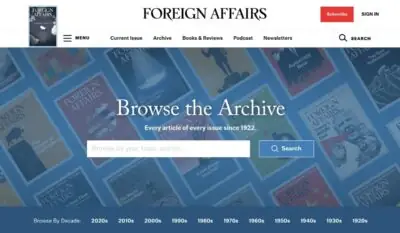In February 2024, State of Digital Publishing (SODP) hosted WP Publisher Success Week – an online event for digital publishing and news media professionals.
This article is based on the summary of key learnings of a fireside chat with Stephanie Solomon, Chief Revenue Officer at Foreign Affairs Magazine.
Foreign Affairs Magazine is a 100-year-old publication launched in 1922 by the Council of Foreign Relations, a prominent think-tank based in New York City. The magazine acts as the public arm of the think-tank, publishing a wide range of articles by leading thinkers and experts in the field of international relations.
The USP of Foreign Affairs Magazine is its ability to provide a window into the thinking of the best minds in the field in a very accessible way. The magazine publishes long-form articles that can be up to 10,000 words in length. They have the following products:
- A print magazine published 6 times per year
- A website that provides access to published articles, archives, and daily analysis
- An app for podcasts, audio articles, and other content
A small but powerful audience
Foreign Affairs Magazine is a relatively small magazine brand with a circulation of around 225,000. The audience is split evenly between US-based readers and international visitors. Instead of doing billboards and other mass branding strategies, their customer acquisition is focused on two strategies:
- By reaching the right people who share the articles
- By getting larger platforms to cite their articles
The thought leadership approach is sustainable for the magazine because of its unique brand appeal. The subscriber base includes a lot of Congress members, world leaders, and other policymakers. Consequently, there is no shortage of high-quality contributors who want to get their articles published in the magazine.
Content Strategy
Foreign Affairs is a small team that doesn’t have the resources to maintain huge video teams and teams that develop product extensions. In such situations, the best option is to focus on the following things:
- Put all your resources into producing the best content possible
- Make sure that the experience of accessing that content on platforms is of the highest quality
- Building a direct connection with the audience (through apps, newsletters, etc)
The important thing is to build a direct connection with your audience, instead of relying on third-party platforms. Foreign Affairs started moving its content away from third-party platforms a long time ago. They actively invested in the development and refining of a mobile app.
“I am glad we did that,” explains Stephanie, “because, at this moment, three out of our top-four traffic channels are ones that we own. And that’s valuable in this day, looking at how rapidly the landscape is changing for search, and how social media has shunned news.”
Directly connecting with your audience through in-house channels like mobile apps, newsletters, magazines, and websites is more stable and long-lasting than trying to build connections with distributed audiences on third-party platforms.
For publishers dealing with long-form articles, audio is a very useful option. The Economist started the trend in 2012 as a retention tool to catch people who did not have the time to read long articles. Many Foreign Affairs readers use the audio feature, particularly on the mobile app.
Retention vs Acquisition
“I like to start with retention,” explains Stephanie. “Because if you start by getting your retention tools tight, it makes it easier to acquire subscribers.”
Streaming giants like Netflix and Disney+ built up a huge list of subscribers without thinking about how they keep those customers. They are now hemorrhaging subscribers without any mechanism to stifle that or figure out why they are leaving.
At Foreign Affairs, it took Stephanie one year in the beginning to get the basics of retention set up the right way. And it is worth taking that effort as acquisition is so much more expensive than retention. This way, when you start acquiring new subscribers, you are actually growing, instead of replacing the ones who are leaving.
Acquiring customers is way more expensive than retaining the ones you already have. Focusing solely on acquisition without addressing issues with retention is like trying to build something on quicksand.
Engagement and Retention Metrics
Retention is the key metric – the number of subscribers who stick around on an annual basis is the North Star metric for a subscription business. The other important engagement metrics worth chasing include:
Content from our partners
- How people are interacting with your articles?
- How many audio files are people listening to, and for how long?
- How are people logging into the app or website?
- When was the last time they logged in?
Subscribers who have not logged in for two months are probably at a high risk of churn. The important thing is to discern various patterns of behavior that can indicate whether people are more likely to churn. And then create re-engagement strategies based on those indicators to prevent churn.
“Retention to me is a very deep and very long tunnel, and a lot of your acquisition problems can be fixed if you bring back existing customers in an effective way.”
Watch the full session:
Download the ebook of learnings from WP Publisher Success Week here.









